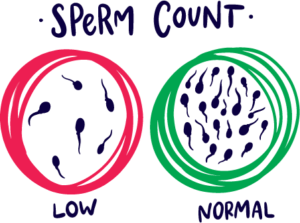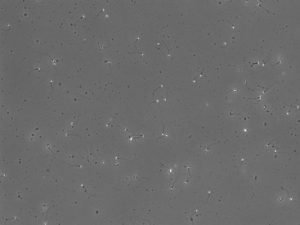Keep Calm and Carry on counting sperm
 For the past 8 years I have been teaching MSc students how to count sperm. However, a few years ago I read an interview published as part of ESHREs In Profile series where Jackson Kirkman-Brown suggests that a sperm count is a relatively poor index of fertility (Kirkman-Brown, 2019), which may lead you to think why bother teach this anymore? Whereas this may or may not be true, I am not here to discuss the clinical utility of sperm concentration, as for me, as a teacher and scientist, there is more to assessing sperm concentration than this. Taking representative samples and using samples to make inferences about unknown populations; being able to understand sample variability; and learning to reason about samples and sampling variability by examining multiple samples drawn from the same population (in this case multiple aliquots from one semen sample)- beginning to sound familiar MSc students! Learning about this and also by considering the factors that can reduce sampling errors (mixing, performing replicate analysis etc etc) demonstrates a concept that is fundamental to science: robustness of methods affects robustness of results.
For the past 8 years I have been teaching MSc students how to count sperm. However, a few years ago I read an interview published as part of ESHREs In Profile series where Jackson Kirkman-Brown suggests that a sperm count is a relatively poor index of fertility (Kirkman-Brown, 2019), which may lead you to think why bother teach this anymore? Whereas this may or may not be true, I am not here to discuss the clinical utility of sperm concentration, as for me, as a teacher and scientist, there is more to assessing sperm concentration than this. Taking representative samples and using samples to make inferences about unknown populations; being able to understand sample variability; and learning to reason about samples and sampling variability by examining multiple samples drawn from the same population (in this case multiple aliquots from one semen sample)- beginning to sound familiar MSc students! Learning about this and also by considering the factors that can reduce sampling errors (mixing, performing replicate analysis etc etc) demonstrates a concept that is fundamental to science: robustness of methods affects robustness of results.
Although this is a fundamental concept that forms the core of the whole scientific process, recent data suggests that scientists don’t necessarily demonstrate this when writing scientific publications, with transparency in method reporting being a problem in different disciplines across the life sciences (Rodgers and Collings, 2021; Bjorndahl et al., 2022). Recently, we highlighted the same problem with the reporting of the technical methods used when assessing different semen characteristics (including concentration) by manuscripts published in the two leading reproductive biomedicine journals, finding the majority of manuscripts not to fully describe the technical methods that they used (Vasconcelos et al., 2022). Although the majority of manuscripts did state that they followed relevant up-to-date WHO recommendations at the time of writing, not fully illustrating this in their method section makes it impossible for the reader to weight-up the robustness of the findings reported in these manuscripts and therefore limits the clinical and research utility of their results and ultimately scientific progress. This is particularly important when performing a semen analysis as it is an inherently heterogeneous sample and a number of technical steps are therefore required to reduce sub-sampling error to give us certainty surrounding our results.
 So what do we do about it? For an educator like me teaching on an MSc course in Human Clinical Embryology and Assisted Conception, I can highlight the importance of performing a robust assessment of the different semen characteristics and fully demonstrating this in written communications through my practical workshops, lectures, journal club sessions and project supervision. In practical sessions students gain hands-on experience in handling semen and using the WHO recommendations to assess the different semen characteristics. Following these sessions, students report their findings in written reports where they are required to fully describe the technical methods used. By comparing their results with their peers and myself, in my experience, gives them greater opportunity to appreciate that semen is actually heterogeneous and sample representativeness, sample variability and sub-sampling error are real concepts and not just something you learn in-order to pass a statistics exam. Beyond the classroom, and as highlighted by a few recent publications (Bjorndahl et al., 2022; Gellatly, 2022), the ‘How to count sperm properly’ checklist proposed by Bjorndahl et al., 2016 should be adopted by all reproductive biomedicine journals when deciding on the acceptability of studies based on human semen analysis.
So what do we do about it? For an educator like me teaching on an MSc course in Human Clinical Embryology and Assisted Conception, I can highlight the importance of performing a robust assessment of the different semen characteristics and fully demonstrating this in written communications through my practical workshops, lectures, journal club sessions and project supervision. In practical sessions students gain hands-on experience in handling semen and using the WHO recommendations to assess the different semen characteristics. Following these sessions, students report their findings in written reports where they are required to fully describe the technical methods used. By comparing their results with their peers and myself, in my experience, gives them greater opportunity to appreciate that semen is actually heterogeneous and sample representativeness, sample variability and sub-sampling error are real concepts and not just something you learn in-order to pass a statistics exam. Beyond the classroom, and as highlighted by a few recent publications (Bjorndahl et al., 2022; Gellatly, 2022), the ‘How to count sperm properly’ checklist proposed by Bjorndahl et al., 2016 should be adopted by all reproductive biomedicine journals when deciding on the acceptability of studies based on human semen analysis.
Having a structured reporting criteria for semen analysis will not only help authors, editors and reviewers, but also our field as a whole as discussions about important questions in andrology like ‘is there a global decline in sperm counts?’ or ‘do antioxidants boast semen characteristics?’ will no longer be reduced to ‘but did they perform their semen analysis correctly….’ We can move beyond this and we will, we just need to Keep Calm, Carry on counting/analysing sperm, but most importantly keep telling people exactly how we do it.
Steven Alexander Gellatly, PhD
Tutor in andrology, MSc in Human Clinical Embryology & Assisted Conception
University of Dundee, School of Medicine, Division of Systems Medicine, UK
References
- Interview with Jackson Kirkman-Brown, 2019. ‘Sperm count is a relatively poor index of fertility’. In Profile, European Society for Human Reproduction and Embryology. Available at: https://www.focusonreproduction.eu/article/Special-Interest-Groups-Limitations-semen-assessment. Last accessed: 15/12/2022
- Rodgers P, Collings A. Reproducibility in Cancer Biology: What have we learned? Elife, 2021; 10: e75830.
- Vasconcelos AL, Campbell MJ, Barratt CLR, Gellatly SA. Do studies published in two leading reproduction journals between 2011 and 2020 demonstrate that they followed WHO5 recommendations for basic semen analysis? Human Reproduction, 2022; deac173, https://doi.org/10.1093/humrep/deac173
- Bjorndahl L, et al. Standards in semen examination: publishing reproducible data based on high-quality methodology. Human Reproduction, 2022; deac189. https://doi.org/10.1093/humrep/deac189
- Gellatly SA (2022). Who follows WHO? Consider this, Fertility and Sterility. Available online: https://www.fertstertdialog.com/posts/who-follows-who?room_id=101-consider-this
- Björndahl L, Barratt CL, Mortimer D, Jouannet P. ‘How to count sperm properly’: checklist for acceptability of studies based on human semen analysis. Human Reproduction, 2016; 31: 227-232.



Leave A Comment